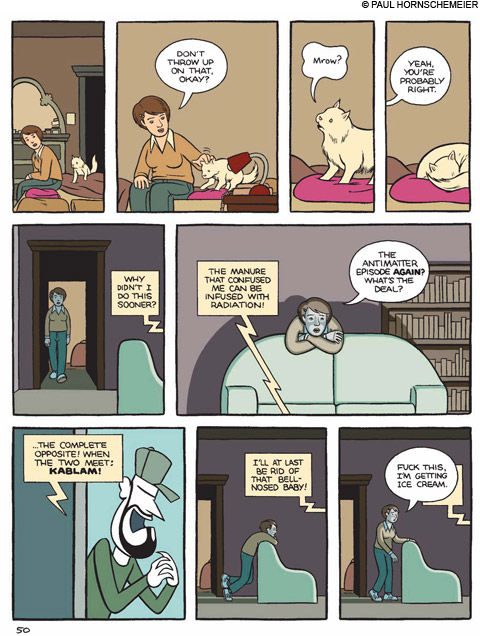
THERE’S A CAT, TOO Hornschemeier’s images tell better stories than the book as a whole. |
You've got to wonder why graphic novels are always so depressing. One friend suggested that Maus is the origin of the grim tone, and another offered Ghost World as the awkward and shuffling culprit. Personally, I think it's because the square is the governing form of comics. As defenders of vinyl sometimes say: analog (alive!) is soft and round whereas digital (dead!) is angular and rebarbative. None of this speculation, however, accounts for the bliss of Snoopy's dance. I propose that his head, nose, eyes, ears, mouth, and feet trump the boxy panel. But how much counterweight do we grant the oblong doghouse, you ask? It's quite the puzzler!
Paul Hornschemeier's Life With Mr. Dangerous is the latest in the graphic novel's grand tradition of despair. Lonely Amy works in a soulless clothes shop, obsesses unhealthily over a cartoon called Mr. Dangerous, recalls — and even executes — a few subpar sexual encounters, and misses her friend Michael, who's just relocated to San Francisco. There's a cat, too. It's tempting to say that the story's a bit sexist — particularly the episode in which our already slightly doughy heroine drives her birthday ennui to an ice cream parlour. Moments before she walks through the door, Amy has a horror fantasy of turning into a Michelin Man-sized blob. The author tries to show sympathy for her "low self-esteem," but the drawings can't help growing obvious — if eloquent — in their disgust. Criticizing Hornschemeier will only give his exhausted gender politics the false appearance of life, though, so perhaps I'd best be quiet. Besides, they're the least interesting thing about this — or any other — book.
The story plods along. With chapter titles such as, "The Day Before You're Older," "Lunch Dates, Lost Notes," and "The I in Team," it reads like mid-'20s, liberal arts grad cliché — an impression not helped by the fact that my review copy was in black and white. If the educated, liberal left (assuming this comic identifies as such) truly imagines that bemoaning the evils of commerce in its art projects makes a difference, God help us all. Shedding oppositional tears while folding shirts at H&M only lubricates the wheels. Why, then, did Jonathan Lethem (who can't be accused of lazy thinking or seeking political short cuts) ask Hornschemeier to collaborate on Omega the Unknown?
The truth is that the illustrations in Life With Mr. Dangerous sometimes approach genius. The first page or two, for example, show Amy on the bus home from work. Buses have long given writers and artists an opportunity for "society-in-microcosm" exercises. It's hard to do something new with this well-worn topos, yet Hornschemeier succeeds. Amy is tired, if increasingly anxious; meanwhile, the hipsterish guy behind her fiddles serenely with his smartphone; the beardo at the back gazes vacantly; a probably fine — but perhaps under-pressure — middle-aged, '50s throwback sits next to her; a thoughtless middle-management type invades her space with his flapping newspaper; an unattractive couple fuss with a book. The twitchy stillness of the images ramps up the tension, and the reflection of Amy's face in the window further opens her inner world to us while (with great economy and tact) introducing the idea of a life elsewhere unlived. The artist captures whole biographies in a few strokes. Even the altering slope of Amy's shoulders from frame to frame adds psychological shading.